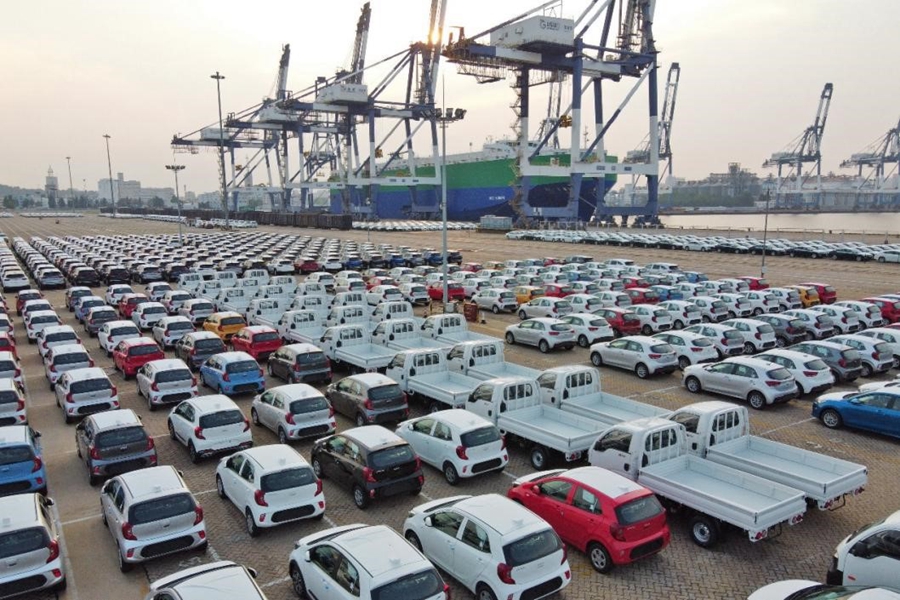China registers foreign trade growth for 14 consecutive months
 |
| Vehicles to be exported are parked at a port in Yantai, east China’s Shandong province, Aug. 7, 2021. (People’s Daily Online/Tangke) |
China’s foreign trade maintained year-on-year growth for the 14th consecutive month in July, said the General Administration of Customs (GAC) on Aug. 7.
The country’s total export and import of goods stood at 21.34 trillion yuan ($3.3 trillion) in the first seven months of this year, up 24.5 percent from a year ago, or 22.3 percent from that in 2019. Exports were 11.66 trillion yuan, growing 24.5 percent year on year, or up 23 percent from 2019, and imports stood at 9.68 trillion yuan, increasing 24.4 percent and 21.4 percent respectively from 2020 and 2019. The trade surplus was 1.98 trillion yuan, up 24.8 percent year on year.
In the first seven months, general foreign trade was 13.21 trillion yuan, up 27.6 percent from a year ago. It accounted for 61.9 percent of China’s total foreign trade, up 1.5 percentage points compared with that a year ago.
Growth was observed in trade with major partners including ASEAN, the EU and the US. In the first seven months, ASEAN was the largest trading partner of China. The total imports and exports between China and ASEAN nations stood at 3.12 trillion yuan, up 24.6 percent. During the same period, China’s imports to the EU, its second largest trading partner, also grew 23.4 percent to 2.96 trillion yuan.
From the January-July period, trade with the Belt and Road countries increased by 25.5 percent to 6.3 trillion yuan.
The private sector saw the fastest growth and an improved proportion in China’s foreign trade. From January to July, private firms reported imports and exports of 10.23 trillion yuan, up 31 percent and accounting for 47.9 percent of China’s foreign trade, 2.4 percentages higher from a year ago. Meanwhile, the imports and exports of foreign-invested companies saw an uptick of 16.7 percent and accounted for 36.4 percent of China’s foreign trade. Besides, state-owned enterprises also saw a 24.4 percent growth in their imports and exports, which took up 15.3 percent of China’s foreign trade.
According to GAC statistics, the exports of mechanical and electrical products maintained positive growth. In the first seven months, China exported 6.88 trillion yuan of such products, up 25.5 percent and accounting for 59 percent of the country’s total exports. Among them, the exports of automatic data processing devices and relevant spare parts stood at 879.28 billion yuan, up 14.2 percent; the exports of mobile phones stood at 485.21 billion yuan, up 15.6 percent; the exports of automobiles (chassis included) stood at 114.08 trillion yuan, up 102.5 percent.
The stable growth of the domestic economy and the enhanced vitality of market entities were the major reason for China’s growing foreign trade, said GAC spokesperson and director of the GAC’s statistics and analysis department Li Kuiwen, adding that they offered strong support for the stability and growth of foreign trade.
China’s stable economic recovery, the momentum for stable growth in major economic indexes such as industrial value-added, fixed asset investment, and total retail sales of consumer goods, as well as the picking-up production demand in the first half of this year, have all laid a solid foundation for foreign trade growth.
Besides, the constant recovery of the world economy has also driven external demand, Li explained. In the first six months of this year, multiple international organizations have lifted their expectation on global growth this year. For instance, the International Monetary Fund in April upgraded its global economic growth forecast to 6 percent, and the World Bank also lifted its forecast to 5.6 percent two months later. The revival of global economy vitalized global trade and the exports of Chinese products.
According to Li, last year's lower base and price factors also, to some extent, helped drive the growth of foreign trade. In the first half of 2020, China’s foreign trade fell slightly by 3.3 percent and was equivalent to that in the same period of 2018. This year, the overall price of international commodity markets has been on a rise. At the end of June, the Commodity Research Bureau Index, a representative indicator of global commodity markets, increased by over 25% since the beginning of 2021 and more than doubled compared with the lowest point in the first half of last year. Influenced by the rising prices of global major commodities, China’s import price index is estimated to be 108.5 for the first half of this year, while the contribution rate of price to import growth is estimated to be 35.4%.
As for China’s foreign trade outlook in the second half of the year, Li said that as COVID-19 keeps wreaking havoc in many parts of the world, China’s foreign trade still faces uncertainties in a complex global epidemic environment. In the second half of last year, China’s total imports and exports grew 27 percent compared with the first half of last year. With a higher base, the growth rate of China’s foreign trade may slow down in the second half of this year. However, imports and exports are still expected to maintain relatively rapid growth throughout the year.
 |
Photos
Related Stories
Copyright © 2021 People's Daily Online. All Rights Reserved.










